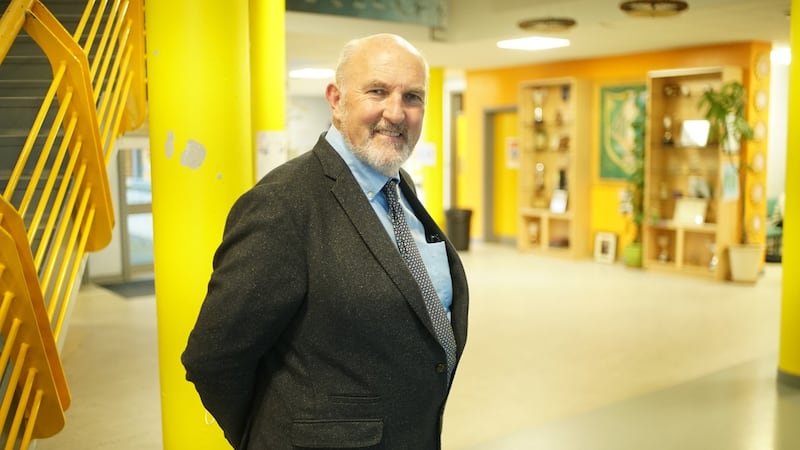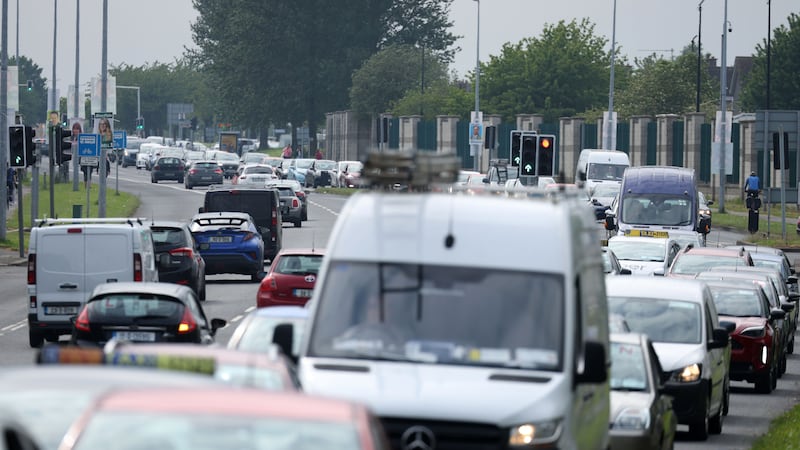At Moville Community College, everybody is talking about mica.
In the staffroom and in the corridors it is the main subject of conversation; on the students’ lockers stickers call for “100% redress”, while at Halloween mica blocks were a popular costume choice.
"There's not an English essay that's passed to a teacher that doesn't have a mention of mica in it somewhere... and every time you mention humanitarian issues it's the first thing to the forefront," says deputy principal Angeline Ruddy.
“It’s on our children’s lips, it’s on our staff’s lips,” she says. “There’s no escaping it. There’s no getting away from mica.”
You're lying at home at night and you hear the walls moving. It's scary, to think you're living in a place that is meant to be your safe place and you're hearing the walls cracking
The presence of the mineral in construction blocks – which makes them crack and eventually crumble – has caused structural damage to an estimated 7,500 homes in counties Donegal and Mayo, as well as smaller numbers in other counties.
Moville, on Donegal’s Inishowen peninsula, is among the worst affected areas. Placards of support for the mica campaigners are on display along the side of the road, while in a nearby village the gable wall of the local shop has been decorated to resemble a mica home, with painted black cracks grasping like tentacles at the slogan “100% redress”.
Mica has impacted the entire community, says principal Anthony Doogan, and the school community is no different.
“You have interviewed a 13-year-old boy who is fluent in building regulations,” he tells The Irish Times. “It doesn’t make sense.[Mica] is completely changing the conversation, and I’m not sure that it’s in a healthy way.”
At Moville Community College approximately 20 per cent of staff and 25 per cent of pupils – about 20 staff and 100 families – are living in "mica homes"; even more have siblings and parents who are affected.

“I have five siblings, and four of them are affected by mica,” says Ruddy. The one who isn’t lives in the US.
“Where I live, in a half mile radius, 20 houses are affected. It’s everywhere we go.”
Her children “know nothing else but a mica household”; as they go about their daily routine, mica is “like an app running in the background for every one of us.
“‘Is the house safe tonight?’ is a regular question my children will ask,” she says. “I have cracks that are now the width of a two-euro coin, which means my gable is starting to move away from the wall of my house. I don’t know, really, if we are safe any longer.”
Others tell a similar story. Special needs assistant Barry Moore’s home is crumbling; his daughter was riding her bike around the house when “a lump of plaster fell off... it was near enough to scare her, and me.”
“You’re lying at home at night and you hear the walls moving. It’s scary, to think you’re living in a place that is meant to be your safe place and you’re hearing the walls cracking.”
Five of the special needs assistants – nearly half of the special needs staff – have mica homes, and so do some of the students they support. A hoist used by one child is attached to a crumbling mica wall, while foster parents have bought two mobile homes to house their children with complex needs.
“They need routine, they need to know what happening... they’re going to be moved into two mobile homes behind their house and watch their house getting knocked down,” says Moore.
In school, he says, you can “see the children who have mica, or whose houses have mica. They are, like their parents probably are, nearly obsessed with the fact they have mica.
“As staff you’re trying to accommodate and support children... but they’re going home to houses that aren’t safe and that are causing them grief and stress.”
Guidance counsellor Sineád McCarron’s home also has mica; she warns of “what’s coming down the line... this is just going to explode, really, in terms of the amount of support the students need.”
As principal, Doogan has significant concerns about the physical and mental health of students and staff – not least through heightened levels of anxiety – and about the impact on students’ attendance and life chances; the effects, he estimates, will persist for the next five to 10 years.
In two years' time, when there's a large number of houses which need to be rebuilt, there will be severe anxiety and perhaps worse felt by a lot of our students
The anxiety of students and parents “is having an impact on their work rate and their effectiveness at their studies at school,” he says.
“Every secondary school in the country”, he emphasises, has seen the effects of Covid; “We’re at the beginning of this cycle for mica and in two years’ time, when there’s a large number of houses in this community which need to be demolished and rebuilt, there will be severe anxiety and perhaps worse felt by a lot of our students.”
There is also “clear evidence” of an increase in absenteeism due to illness – “they’re living in draughty rooms, the rooms are colder, the rooms are causing them health issues that they wouldn’t ordinarily have” as well as students from mica homes who have left school altogether.
Brother and sister Shaun and Aoife Noone describe how their home is "falling down": "If I put my hand in the wall I could just pull away some of the side of the house," says 17-year-old Shaun.
They have moved out so that their home can be demolished and rebuilt. “I don’t really have a study room so that’s affecting my study, because I’m doing my Leaving Cert now, and it’s harder to focus and settle down and get work done,” he says.
“I feel disadvantaged, it’s unfair that most people would stress or be anxious about exams but I’ve got the pressure of my house on top of that, so it’s a bit hard on the mind as well.”
Aaron Price (13) and his family have also moved out. "It was a lot to handle trying to go to school and do homework and trying to empty the house."
We need 100 per cent, and I know we probably will never get that, but if it was in Dublin, this would already be fixed
The Government this week announced a €2.2 billion scheme to rebuild mica homes in Donegal and Mayo, capped at €420,000 per home and with a sliding scale of rebuilding costs from €145 per sq ft for the first 1,000 sq ft to €110 for the next 1,000 and €100 thereafter.
It has been criticised by the mica campaigners in Donegal as falling short. “Apparently a new scheme was decided but it’s stupid, apparently each square metre gets less money, that doesn’t make sense,” says Aaron.
“We need 100 per cent, and I know we probably will never get that, but if it was in Dublin, this would already be fixed.
“It’s not our fault, we spent a lot of money on building our house... why should we have to spend more and more money rebuilding our house?”
The adults have done the figures; each of those spoken to by The Irish Times is facing a shortfall of between €60,000 to €80,000. “If council houses are being built at the minute they are built on a rate of €150 a square metre,” says Moore. “What was being offered would work out essentially for our house at €127 a square metre, which would leave us paying €65,000 on top of what we would get.
“My other half is a psychiatric nurse, we’re no millionaires, we’re working-class people and we live in an average size house in Donegal which is the average in the country for a one-off build, 2,500 sq ft.
“If they had dropped the sliding scale part... 145 euro per square foot, that’s it, and then your rent and then your storage, I would say 90 per cent of people would have been happy and celebrating, but they put in a scale that doesn’t exist in any builder’s pricing.”
“The cost to me right now is €79,000, and that’s just for the build,” says Ruddy. “My house is 2,600 sq ft... that gives a total of €315,000 of a grant. The builders have come back to me with €395,000.
Because we're that far away and we're rural they say 'ah, them Donegal ones, they live in big mansions, they can afford it'. We can't
“I can’t borrow because I have a mica home... 100 per cent redress is so far from it, I don’t think I’m even getting 80 per cent redress.
“My children are at the stage where I should be starting to save for their college. Am I going to build their house and deprive them of education? We’re facing these choices.”
“People bought the material in good faith... yet they are being victimised to the extent of having to spend 40, 50, 60, €80,000, whereas other areas were given 100 per cent redress,” says Doogan.
For him, it is about the value placed on people from this area, not least given that the school itself is still “nowhere near completion” 20 years after it opened. “We bailed out the banks for €64 billion, and they’re saying three or four billion is a huge amount of money, but it’s less than five per cent of what we gave to the banks.
"The people up here paid their taxes to pay for the bank bailout, and people here, like me, paid their taxes to pay for the pyrite redress in Dublin and Leinster. People round here are saying, 'is there a different law for us?'"
McCarron, too, is clear: “How can we help people look after their wellbeing and instil value systems of fair justice when our own Government continues to let this happen?”
“They’ve let us down,” says 15-year-old Aoife. “If this was happening in Dublin, I feel it would be a different story, because we’re that far away and we’re rural they say ‘ah, them Donegal ones, they live in big mansions, they can afford it’. We can’t. We need our houses fixed.”











